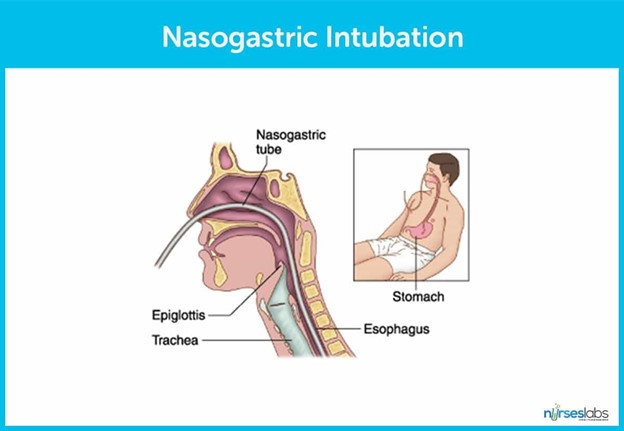A nurse is caring for a client who is receiving continuous enteral feeding via NG tube.
Which of the following is an unexpected finding?
Gastric residual of 300 mL at the end of the shift.
Weight gain of 0.91 kg (2 Ib) in 2 days.
Blood glucose level of 110 mg/dL.
Diarrhea one time in a 24-hr period.
The Correct Answer is A
Gastric residual of 300 mL at the end of the shift is an unexpected finding.
Gastric residual volume refers to the volume of fluid remaining in the stomach during enteral feeding.
A gastric residual volume of less than or equal to 500 mL every 6 hours is considered safe and indicates that the gastrointestinal tract is functioning.

Choice B is wrong because weight gain is expected during enteral feeding.
Choice C is wrong because a blood glucose level of 110 mg/dL is within the normal range.
Choice D is wrong because diarrhea can be a common side effect of enteral feeding.
Nursing Test Bank
Naxlex Comprehensive Predictor Exams
Related Questions
Correct Answer is D
Explanation
The correct answer is d. Unplug the pump.
Rationale for Choice A:
- While notifying the biomedical department to fix the pump is important,it is not the immediate priority in this situation.The first step is to ensure patient and staff safety by removing the potential electrical hazard.
- Delaying the removal of the sparking pump could lead to electrical shock,fire,or other serious consequences.
- Biomedical staff can be notified after the immediate safety risk has been addressed.
Rationale for Choice B:
- Obtaining a replacement pump is necessary to continue the client's IV therapy,but it is not the first action the nurse should take.
- The priority is to eliminate the electrical hazard posed by the sparking pump.
- Once the faulty pump is unplugged and safety is ensured,the nurse can then proceed to obtain a replacement pump.
Rationale for Choice C:
- Labeling the pump with a defective equipment sticker is important to prevent others from using it,but it does not address the immediate safety risk.
- The priority is to disconnect the pump from the power source to eliminate the risk of electrical shock or fire.
- Labeling can be done after the pump has been unplugged and the situation has been assessed.
Rationale for Choice D:
- Unplugging the pump is the correct first action because it immediately removes the electrical hazard,preventing potential harm to the patient,staff,or equipment.
- This action prioritizes safety and mitigates the risk of electrical shock,burns,fire,or other serious consequences.
- It is essential to act quickly and decisively in such situations to ensure a safe environment for everyone involved.
Correct Answer is A
Explanation
Secure the tracheostomy ties to allow one finger to fit snugly underneath. This is important to ensure that the tracheostomy tube is secure and in place.
Choice B is wrong because normal saline is not typically used to cleanse the skin around the stoma.
Choice C is wrong because soaking the outer cannula in warm, soapy tap water is not a recommended method of cleaning.
Choice D is wrong because a cotton tip applicator should not be used to clean inside the inner cannula.
Whether you are a student looking to ace your exams or a practicing nurse seeking to enhance your expertise , our nursing education contents will empower you with the confidence and competence to make a difference in the lives of patients and become a respected leader in the healthcare field.
Visit Naxlex, invest in your future and unlock endless possibilities with our unparalleled nursing education contents today
Report Wrong Answer on the Current Question
Do you disagree with the answer? If yes, what is your expected answer? Explain.
Kindly be descriptive with the issue you are facing.
